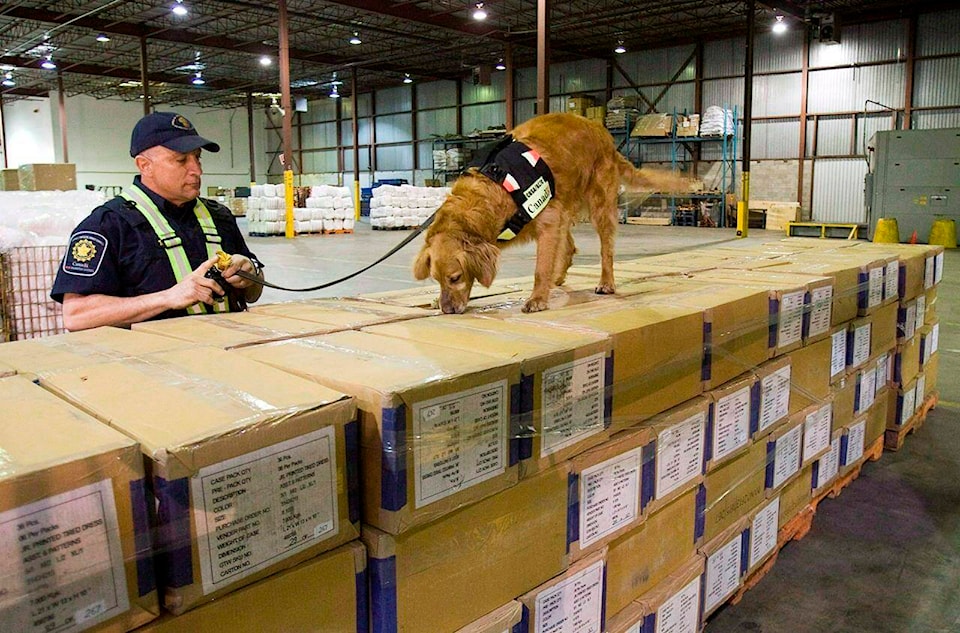Detector dogs who work at CanadaәҰРЯІЭСРҫҝЛщҷs border agency could play a bigger role in sniffing out deadly fentanyl and illicit firearms, suggests an internal evaluation that found room to boost enforcement measures.
The Canada Border Services Agency has dozens of canines trained to detect smuggled currency, drugs, guns, and food, plant and animal products.
A recently published evaluation by the agency says the detector dog service has helped reduce threats by effectively intercepting such regulated and prohibited goods at the border through әҰРЯІЭСРҫҝЛщңefficient and non-intrusive examinations that save time.әҰРЯІЭСРҫҝЛщқ
The border agency program employs Labrador retrievers, beagles and other breeds, with dogs typically 11 to 16 months old when training begins at a centre in Rigaud, Que.
Only one of every 10 dogs considered for the program is accepted.
The dogs live with their handlers, travel in air-conditioned vehicles and have an average working life of six years.
Each dog is trained to zero in on a specific type of odour, meaning, for example, ones that sniff for currency are not used to detect food products.
Dogs were once trained to scratch, dig, bite and bark at the source of a contraband odour, the border agency says. However, they now generally give a subtle signal to their handler upon finding something.
In October 2021, detector dog Piper and handler Kyle were brought in to scrutinize a car that arrived from the United States via the Ambassador Bridge linking Detroit and Windsor, Ont., the evaluation report says.
After Piper signalled several finds, border services officers discovered a handgun with the serial number filed off, a second handgun that was determined to be stolen, and 256 grams of marijuana. The driver was later sentenced to one year behind bars.
It would have taken several hours and four or five border officers to tow the vehicle to X-ray it, the report adds.
However, the evaluation says that overall the detector dog program had a limited role in finding smuggled firearms, presenting an opportunity to assess how efforts әҰРЯІЭСРҫҝЛщңcan be maximized in this area.әҰРЯІЭСРҫҝЛщқ
Some portions of the report were redacted, as they were considered too sensitive to make public.
In December 2021, detector dog Kaya and handler Tracey were called to examine a pallet of boxes at a marine facility on the West Coast. A narcotics trace scanner had turned up nothing, but Kaya indicated something of interest.
әҰРЯІЭСРҫҝЛщңFurther testing revealed the unknown substance as a fentanyl precursor, with the amount seized valued at $18 million,әҰРЯІЭСРҫҝЛщқ the report says. әҰРЯІЭСРҫҝЛщңDetector dogs not trained on fentanyl may not have indicated on the substance, in which case it likely would not have been sent for further testing.әҰРЯІЭСРҫҝЛщқ
With the increase in illegal drug exports from Canada, including fentanyl, interception of the shipment helped prevent more of the deadly substance from being produced and distributed, the report adds.
Even so, the evaluation says some dog handlers and their managers saw a need to train more canines to intercept fentanyl and precursor chemicals used to make such drugs.
While Canada legalized recreational cannabis use in 2018, it remains illegal to transport the drug across the border, the report notes. Some people interviewed by the evaluation team questioned the continuing need for the border restriction.
The evaluation report recommends further review of the detector dog program, performance results, and allocation of resources to determine how the animals could be best used for enforcement.
In a response included in the report, border agency management agreed to complete such a review by June to ensure the program is әҰРЯІЭСРҫҝЛщңfocused on the areas of highest risk.әҰРЯІЭСРҫҝЛщқ
READ ALSO:



